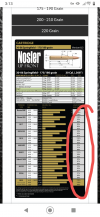That's awesome news. I'm building a 18" 308 now off a Kelbly Atlas. This will be tried out for sure.I just finished a load for my young boys to shoot in my 308
124 hammer hunter
Lapua brass
Cci200
49.4gr of IMR 8208 xbr
3075 fps out of a 16" 308
Bartlein 5r barrel.
.36View attachment 280013 moa 3 shot group
-
If you are being asked to change your password, and unsure how to do it, follow these instructions. Click here
You are using an out of date browser. It may not display this or other websites correctly.
You should upgrade or use an alternative browser.
You should upgrade or use an alternative browser.
Hammer Hunter Load Data, (See page 1, Post 8)
- Thread starter GLTaylor
- Start date
 Help Support Long Range Hunting Forum
Help Support Long Range Hunting Forum
Matt Tatum
Well-Known Member
It is compressed, but no pressure sign. Col was 2.725.
Any crimp used?It is compressed, but no pressure sign. Col was 2.725.
Matt Tatum
Well-Known Member
No sir.
6mm Remington
70 HH
26" T/C Custom Shoo 1:10
Remington brass 1/8 T FCD
Federal 210M
2.9045"
H4350
49.8 grains
3,856 fps ES 7 SD 4 gr .206" @ 100 yards
I tested 5 loadings with H4350 this morning. Largest group was .421" and all had single digit ES. Just what we've all come to expect from Hammer bullets.

70 HH
26" T/C Custom Shoo 1:10
Remington brass 1/8 T FCD
Federal 210M
2.9045"
H4350
49.8 grains
3,856 fps ES 7 SD 4 gr .206" @ 100 yards
I tested 5 loadings with H4350 this morning. Largest group was .421" and all had single digit ES. Just what we've all come to expect from Hammer bullets.
That's freaking awesome6mm Remington
70 HH
26" T/C Custom Shoo 1:10
Remington brass 1/8 T FCD
Federal 210M
2.9045"
H4350
49.8 grains
3,856 fps ES 7 SD 4 gr .206" @ 100 yards
I tested 5 loadings with H4350 this morning. Largest group was .421" and all had single digit ES. Just what we've all come to expect from Hammer bullets.
View attachment 281280
dougduey
Well-Known Member
I second that!!That's freaking awesome
epags
Well-Known Member
Steve's Opening Reminders:
We recommend looking for a powder showing fairly high load density for similar weight bullets, but not compressed. We like to use powders that show a 90-95% load density with conventional bullets of the same weight. This will leave some room for the longer copper bullet and for the lower pressure possibly needing a bit more powder to get to pressure.
I reload but do not understand how to 'calculate' this 90-95% load density for a perticular caliber. Say 30-06 and 7mm Magnum? Is there a formula or is it a hit-or-miss trial? Please discuss.Post 6-23-21
G
Powder charge / case capacity x powder bulk density. Or you can put your calculator away and refer to the Nosler manual or website.
Referring to Nosler data is easiest.
epags
Well-Known Member
Dog gone it. You just made me buy a new Nosler manual (9). I have new Sierra and Honrady but my Nosler is #1 1976. It will be for sale on ebay after I get my new one.Powder charge / case capacity x powder bulk density. Or you can put your calculator away and refer to the Nosler manual or website.
However, where does one get the 'powder bulk density' information?
Last edited:
Just go on line. No purchase necessary.
jeremy.b
Well-Known Member
Just go on line. No purchase necessary.
Example
